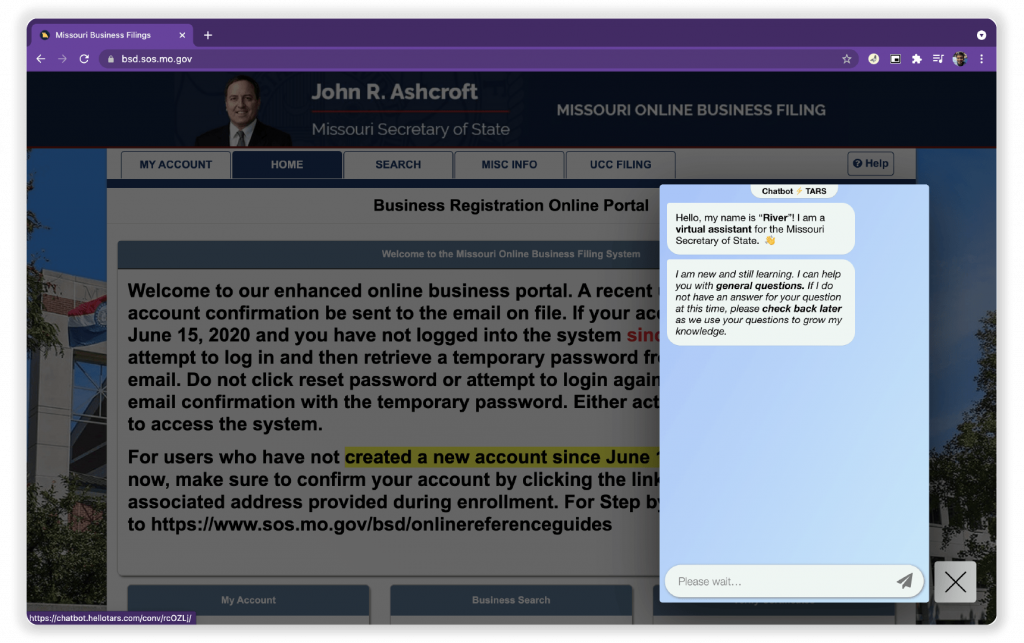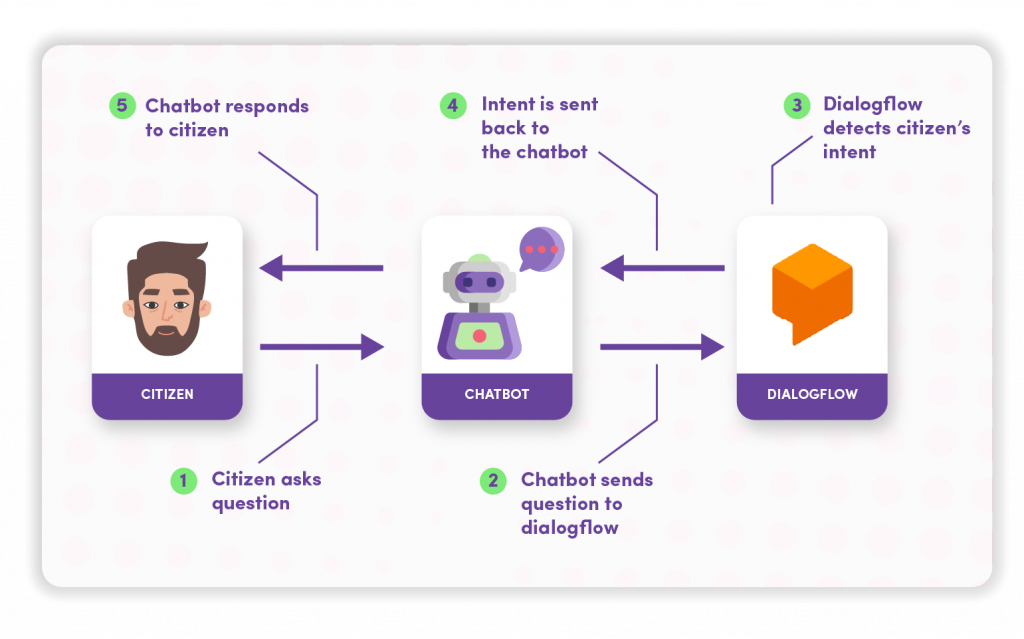For years, Missouri’s Secretary of State faced a problem that is common in the world of government. They were receiving thousands of customer service questions that they couldn’t answer efficiently. This led to clogged employee inboxes, long helpline hold times, and worst of all, low citizen satisfaction.
Using Tars chatbots, they were able to turn the tide on this customer service nightmare in their Business Services Division (BSD) and today, their automated customer service agent, River, is able to lighten the workload on BSD employees while giving citizens the instant answers that they desire. To date, River has automated 200,000 conversations with a 97% success rate. We spoke with the Secretary of State team about how they were able to achieve these results using the Tars platform.
About the Business Services Division
Whether you run a neighborhood bakery or a multinational corporation, starting and running a business is a bureaucratic affair. From licensing to corporation fees, trademarks to registration, business owners are constantly interacting with the government to run their business efficiently and legally.
In the State of Missouri (as in all other states), the Secretary of State handles most of these services through their Business Services Division.

The BSD, as it is called for short, has a dedicated website on the Secretary of State domain. This website contains all of the possible information and forms that a business owner would possibly need to run their business. In theory, it should make the process considerably easier as business owners can access all of this information without having to go into a physical office or calling BSD over the phone. In practice, however, the situation is quite different.
Customer Service Problems
Government agencies and divisions deliver dozens of services to citizens and it is unwieldy to present the wealth of information, rules, and conditions associated with those services as regular websites. What invariably ends up happening is that these websites are a mess of links and mobile-unoptimized PDFs that citizens simply do not have the patience to navigate. So even if the website contains all of the information that citizens could possibly need, they can rarely, if ever find the specific information that they need.

BSD’s website was no different. It suffered from both of these problems. Business owners had questions about a variety of topics ranging from complex queries about the intricacies in the business registration process to more basic queries like those relating to password resets for the portal. But while all of this information was housed on the BSD website, citizens found it hard to find the information they were looking for.

The end result was that citizens were pushed towards BSD’s customer service channels: email & helpline. While both email-based and phone-based query resolution got the job done, they suffer from two flaws that made them untenable for BSD’s use case.
First, they both have a high turn around time (TAT). The unfortunate reality of human-dependent customer service is that the number of queries often outstrips the number of available agents or employees to respond to those queries. This results in high turn around time for even the most basic queries which in turn causes high citizen frustration.
Second, they both lack 24/7/265 availability. The employees who man the email ids and phone lines are available only available during work hours. This means that if citizens have questions after work hours, on weekends, or on holidays there is no one that can serve them, thus further increasing frustration.

Together these issues led to a lose-lose situation where employees were buried under a mountain of emails and phone calls they couldn’t get to and citizens were frustrated because they couldn’t find the information that they needed. Suffice it to say, the system didn’t work for any of the stakeholders involved.
Using Chatbots To Automate Customer Service Conversations
To address these problems, BSD decided to deploy a Tars customer service chatbot, named River, to their business registration portal.

River serves as a fully automated onsite concierge that addresses customer service queries without assistance from a human agent. The specifics of this chatbot deployment have been detailed below.
How Citizens Access The Chatbot
River is accessible through a widget on the bottom right corner of BSD’s business portal.

The chatbot widget is designed in such a way that it appears on all pages of the BSD domain. So regardless of where on the site the citizen navigates to, they will be able to access it.
The Citizen Journey While Using The Chatbot
When a citizen first clicks into the conversation, the chatbot introduces itself and prompts the citizen to ask their query using the provided input area.
Citizens are able to type out their query in their own words which makes using the chatbot about as easy as texting a friend.

After the citizen submits their question, the chatbot sends that question through an API call to Dialogflow, which is an NLP engine.
BSD worked with the Tars team to create a custom text classifier in Dialogflow that can identify user intent in BSD-related questions. The classifier processes the citizen’s query identifies intent and sends it back to the chatbot.

The chatbot responds to the citizen based on their intent, giving them an answer to their questions.
If the NLP engine can’t identify the correct intent and the citizen is not satisfied with the chatbot’s response, then the chatbot collects the citizen’s email and passes the query on to the BSD team. These unanswered questions are then handled over email.

Effect

While the chatbot isn’t 100% successful at answering questions, it is pretty close. Since deployment, it has fielded over 200,000 questions with a 97% success rate. Those 200,000 questions, in turn, translate to 200,000 fewer emails and phone calls that would have otherwise been fielded by BSD employees.
From a citizen’s perspective, questions handled through the chatbot have a non-existent TAT as the chatbot is able to answer instantly. Additionally, since it is fully automated, it’s able to deliver this instant support to millions of people concurrently, 24x7x365. So if for whatever reason, BSD were to receive a million customer service questions on Christmas morning, they’d be able to handle them using their chatbot.

While BSD’s results are undeniably remarkable, the problem they faced is common in the world of government. If your agency faces a similar customer service problem, book a demo with us today to explore whether a chatbot is right for you.

Arnav is the Director of Content Marketing at Tars. He spends most days building bots, writing about conversational design and scrolling through Giphy’s trending section looking for the gifs that go into the Tars Newsletter.

0 Comments on "How The Missouri Secretary of State Automated 200,000 Customer Service Conversations Using A Chatbot"